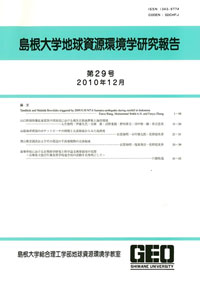島根大学総合理工学部地球資源環境学教室
ISSN:1343-9774

ダウンロード数 : ? 件
この文献の参照には次のURLをご利用ください : https://ir.lib.shimane-u.ac.jp/31600
島根大学地球資源環境学研究報告 33
2015-02-27 発行
White micas from the Seba eclogitic basic schists in the Sambagawa metamorphic belt, central Shikoku, Japan
ファイル
内容記述(抄録等)
The Seba eclogitic basic schists in the Besshi district of central Shikoku consist mainly of garnet, omphacite, sodic, sodic-calcic and calcic-amphiboles, epidote and phengite along with small amounts of chlorite, albite, quartz, rutile and titanite. Calcite and hematite occur occasionally. Phengites in the eclogites have three modes of occurrence (Ph 1-3). Phengites (Ph1) occurring in the matrix have a schistosity. Relatively thicker flakes of phengites (Ph2) occasionally grow oblique to the schistosity, and phengites (Ph3) replace porphyroblastic garnets along their rims and cracks. Phengites in the Sebadani area show extensive range of chemical compositions, suggesting a variety of equilibrium metamorphic P-T conditions. Phengites (Ph1) have higher in Si and a compositional zoning with increasing Si from core to rim, suggesting a prograde growth zoning. Therefore, phengites (Ph1) were probably crystallized during prograde to peak metamorphism in the eclogite facies. Some phengites in the matrix (Ph1) showing decreasing Si contents from core to rim are probably developed during the retrograde metamorphism of the eclogite. Phengites (Ph2) occurring with random orientation to the schistosity, and phengites (Ph3) replacing the porphyroblastic garnets suggest that eclogites in the Sebadani area also suffered another high-pressure metamorphism, that probably corresponds to the Sambagawa metamorphism of the epidote-amphibolite facies in the Besshi area.
Other Article
PP. 19 - 27
